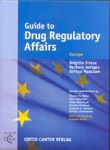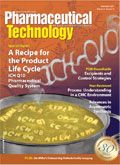How to Gain Approval Overseas
A comprehensive book helps readers navigate the European drug-approval process.
The recent book Guide to Drug Regulatory Affairs provides complete and thorough information about the regulatory approval process for human medicinal products in the European Union. The book was edited by Brigitte Friese, Barbara Jentges, and Usfeya Muazzam, and was published in 2007. It is packed with tables, figures, and flow charts that offer quick access to precise and timely data. The book's contributing authors have expertise in regulatory affairs and work in various European regulatory offices. The text is well written, easy to understand, and comprehensive.

Naushad Khan Ghilzai
The book's four parts describe the European Agency for the Evaluation of Medicinal Products's (EMEA) approval process. They explain the application procedure, requirements, and how to obtain marketing authorization to make finished medicinal products commercially available in the European market.
Part A deals with the procedures, laws, and material requirements for marketing authorization. Chapters 2 and 3 briefly discuss the essential terms and provisions of the EU's pharmaceutical laws and describe EMEA's organizational structure and responsibilities.
Part B informs readers about the formal requirements for the submission and approval process, including legal requirements. It also describes various practical aspects of regulatory compliance. The second chapter of Part B clarifies the issues pertaining to the submission of marketing authorization applications according to the EU Common Technical Document (CTD), the harmonized format for regulatory license applications in the EU, which took effect in 2003. The authors explain how to prepare and submit the CTD to the EU and to individual country's regulatory agencies.

Guide to Drug Regulatory Affairs, Brigitte Friese, Barbara Jentges, and Usfeya Muazzam, Eds., Editio Cantor Verlag, Aulendorf, Germany, 2007, 1103 pp., ISBN 3-87193-324-4
This part also provides a detailed description of the application procedure for marketing authorization. It explains requirements, including data about the quality of drug substances and drug products, and nonclinical and clinical study reports, that should be included in EU CTD modules 1–5. In addition, the section provides regional administrative information for each EU member country; high-level summaries of product quality, safety, and efficacy; and clinical and nonclinical data. The last chapter includes the approval process for granting the marketing authorization in Switzerland, which is not an EU country.
Part C explains how to obtain marketing authorization for special drug products, including blood and blood products, advanced therapy medicinal products, radiopharmaceuticals, orphan drugs, and traditional herbal medicines.
The last part of the book provides helpful information such as a list of Internet resources and application forms.
The editors and authors have taken exceptional care to italicize and highlight the important words, definitions, tables, and paragraphs in each part of the book. This book supplies relevant details about the process for getting EMEA approval for medicinal products and special drug products. It examines EMEA's role in regulating human drug marketing.
This book contains many legal and regulatory references for the European marketing-authorization procedure. It is most useful for readers who wish to gain a deep understanding of the procedural and legal issues involved in submitting medicinal products to the EU and EMEA for approval.
The book is more than 1000 pages long and might be a little intimidating to those who seek quick references when filing for marketing authorization in Europe. The authors have worked diligently, however, to ensure that the book's contents are well presented. On the other hand, the book lacks a short summary of each of its parts. Therefore, readers may have difficulty finding information quickly about the filing process for approval.
Not many references for this subject are available, and this one is written in a simple way that makes it useful to the pharmaceutical industry and to regulators. In brief, the book supplies everything a manufacturer would need to plan a regulatory filing.
Naushad Khan Ghilzai is an associate professor in the Department of Pharmaceutical Sciences, LECOM School of Pharmacy, 1858 W. Grand-view Blvd., Erie, PA 16509, tel. 814.860.5134, fax 814.860.5123, nghilzai@lecom.eduwww.lecom.edu

Entering New Domains for 3D Printing of Drug Products
April 6th 20253D printing of personalized medications is currently possible under existing compounding regulations, offering enhanced process control through automation. But new legislation coming in 2025 will allow 3D printing as part of a distributed manufacturing framework.